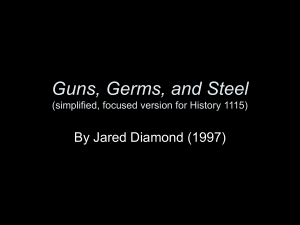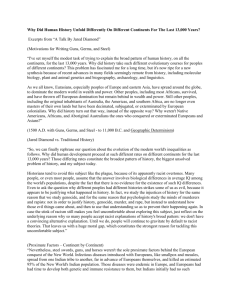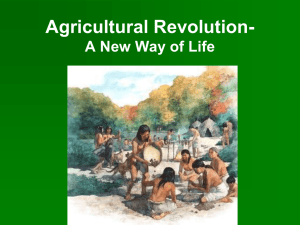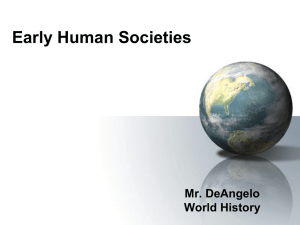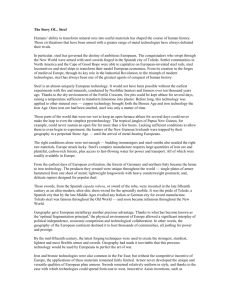Geography and Global Domination
advertisement
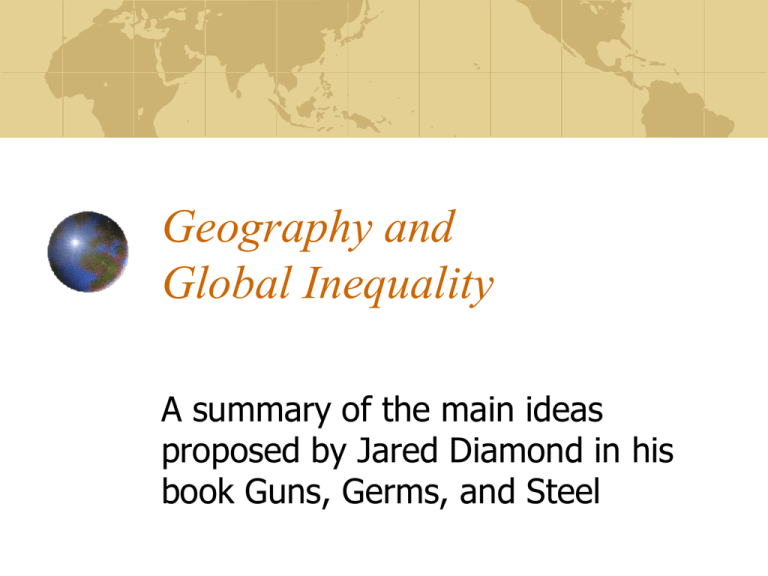
Geography and Global Inequality A summary of the main ideas proposed by Jared Diamond in his book Guns, Germs, and Steel Yali’s Question Jared Diamond is a biologist and anthropologist On Papua New Guinea Diamond befriended an aboriginal man named Yali Yali asked Diamond, “Why is it that you white people developed so much cargo and brought it to New Guinea, but we black people had little cargo of our own?” In short, how can we account for western societies’ (European nations and their offshoots) disproportionate levels of power and innovation? Diamond’s Thesis Geographical factors determined the development of civilizations and patterns of conquest “…history followed different courses for different people because of differences among people’s environments, not because of biological differences among people themselves.” Proximate Causes (such as guns, germs, and steel) were the result of Ultimate Causes (such as access to plants and animals that could be domesticated) Unequal Starting Points According to Diamond, different societies developed at different rates due to unequal starting points The ability to develop the proximate causes of dominance—guns, germs, and steel—depends upon geographical factors that determined the relative ease with which a group of people could hunt, gather, & farm In other words, the easier it was for people to farm (using domesticated plants and animals), the more likely they were to develop advanced civilizations Plant Power Certain grains such as wheat and barley have much larger seed sizes, thus making it worthwhile to gather them instead of hunting Areas where grains with large seed sizes grew were naturally more conducive to settlement and farming Sources of Plant Production Farming and planned food production were developed in many different regions around the world. So what made the fertile crescent different than these other regions? Taming Beasts Key to successful sedentary villages is the ability to domesticate animals for food, energy, and other services To be domesticated, animals must be naturally inclined to breed in captivity and be safe around people--they must have passive temperaments The most common domesticated mammals are sheep, goats, cows, oxen, pigs, and horses The ancestors of most modern domesticated animals inhabited Eurasia and North Africa Mammalian Domestication What factors make some animals capable of domestication while others are not? Just like plants, all animals are not created equal. Most animal species would not benefit people even if they were tamed and, of the species that might be beneficial to people, only some are capable of being tamed. Also like plants, potentially beneficial mammalian species were not evenly distributed around the world. Runners take your marks… Imagine a race in which each runner starts at a very different place on the path. Naturally not all the runners would finish the race at the same time. Just like that race, different regions domesticated plants and animals at different times in history. Because of this, some regions developed advanced civilizations earlier in history than others. An Unfair Race Not only are the starting points different, but some places can more easily adapt imported technologies, plants, and animals As villages and settlements grow, they often trade goods, services, and ideas with nearby villages; however, trade may be limited by physical geography such as mountains, large bodies of water, deserts, and harsh climates. Plants and animals that flourish in some environments may not survive in other environments (for example, why are there so few palm trees in Oregon, but lots in California?) The extent to which technology, such as new crops or breeds of domesticated animals, can spread depends upon the ease with which different communities of people can adapt them to their own climate and region Axis of Power Crop and animal diffusion depends upon similarity of climates. Thus, the ease with which fertile crescent crops spread across the world can be understood as a result of similar climates along an East-West axis. Farming Leads to Conquest So how do crops and domesticated animals lead to advanced civilizations and conquest? Once people can stop moving around and have access to stored food they have more leisure time to devote to innovation and technology More food and more time also results in more births As populations increase societies adopt rules and codes of conduct to regulate the increasing interactions between people and groups Population pressures also lead to competition for scarce resources (the roots of conflict and wars), as resources increasingly become scarce and populations continue to grow, people look elsewhere for new resources Ultimately nearby populations are forced to either adopt their neighbors’ technological advantages or be conquered (either through violence or overwhelming numbers) What About Disease? Disease History demonstrates that not only is conquest typically the result of technological imbalance but also immunity imbalance Most deadly diseases are mutations of animal disease. Proximity to animals transmits the diseases. Societies with domesticated animals have more exposure to diseases and build immunities As societies spread, diseases spread with them So why isn’t the Middle East more powerful? Climate change and overuse of the land in the Middle East led to the collapse of many of the advanced societies in the region (but not before their technology spread) Europe was the chief beneficiary of the Middle East’s head start because of similar climates and the relative ease of transportation and trade via it’s seas and rivers, thus Europeans ended up having a technological head start in the race toward guns, germs, and steel Europe’s Advantage Crops, domesticated animals, and ideas from the fertile crescent spread throughout Europe, kickstarting sedentary farming villages European societies developed quickly due to the rapid diffusion of technology from the Middle East (allowing Europe to skip over the long periods of time normally necessary for such advancements in technology) To Sum Up… Global inequality is a result of which societies had natural and geographical head starts leading to earlier advances in technology Immediate (proximate) causes of conquest such as guns, germs, and steel are really just the natural outgrowth of the more distant (ultimate) causes such as physical geography and availability of plant and animals that can be easily domesticated So what does the title of Diamond’s book mean? Guns represent the weapons of war developed due to conflict over resources and ultimately used to conquer others Germs represent the diseases resulting from domesticated animals, which devastate unexposed populations (intentionally or not) Steel represents technological innovations (especially in tools, communications, and transportation) which provide conquering civilizations the advantage over competing societies Resources Used Diamond, Jared. (1997). Guns, Germs, and Steel: The Fates of Human Societies. W.W. Norton & Company, NY, NY. http://alliance.la.asu.edu/temporary/fogel/Fo gelDiamondGunsHandout.pdf All the charts and tables used are from this website


